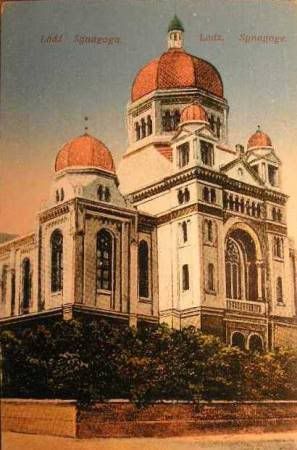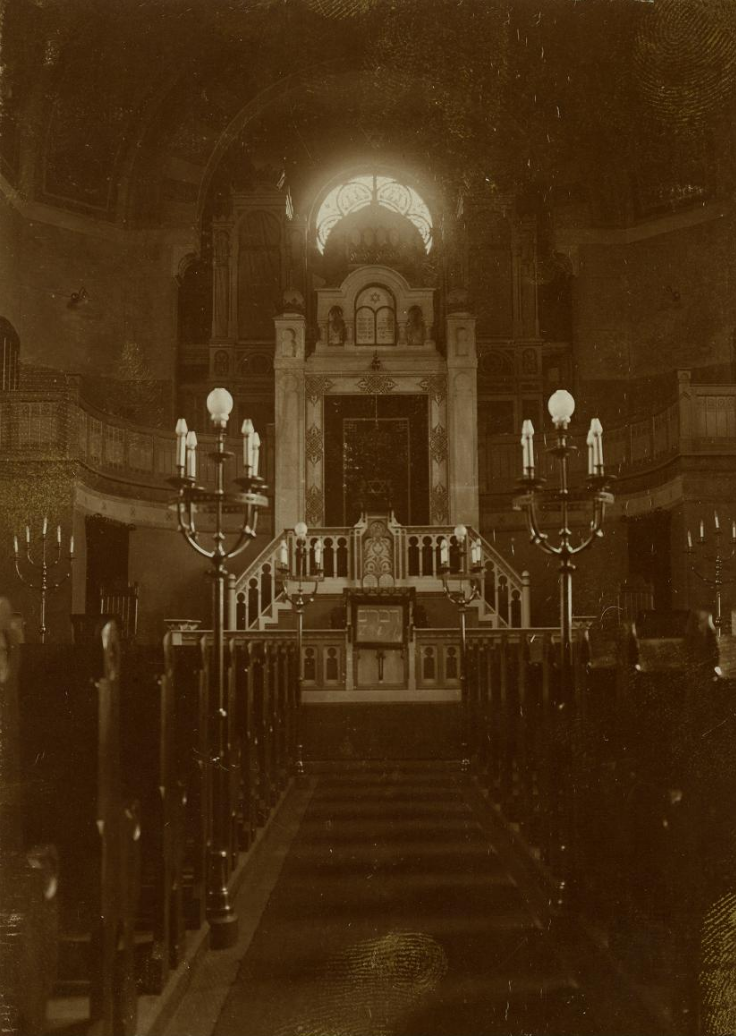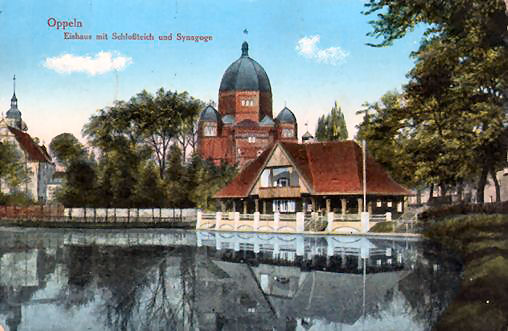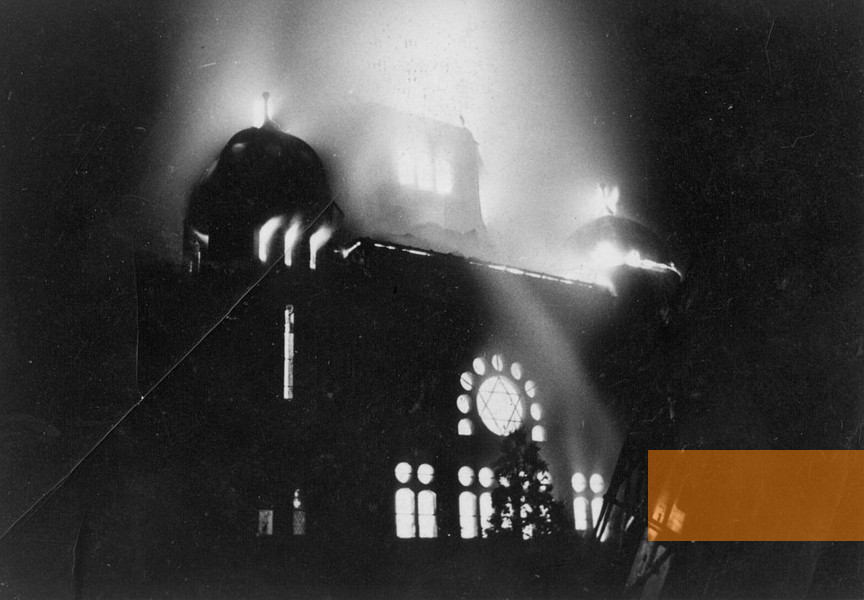|
|
Post by Bonobo on May 16, 2016 18:42:18 GMT 1
Great Synagogue in Warsaw - Germans blew it up 73 years ago.
The Great Synagogue of Warsaw was one of the greatest buildings built in Poland in the 19th century and at the time of its opening was the largest synagogue in the world. It was located on Tłomackie street in Warsaw.
Opened on 26 September 1878 in the celebration of Rosh Hashanah (Jewish New Year), it was personally blown up by SS-Gruppenführer Jürgen Stroop on 16 May 1943, which was the last act of destruction of the Jewish ghetto in Warsaw by the Germans.
The Great Synagogue was built by the Warsaw's Jewish community between 1875 and 1878 at Tłomackie street, in the south-eastern tip of the district in which the Jews were allowed to settle by the Russian Imperial authorities. The main architect was Leandro Marconi.
After the Warsaw Ghetto Uprising, on May 16, 1943 the SS blew up the building. It was not rebuilt after the war.
SS-Gruppenführer Jürgen Stroop later recalled:
"What a marvelous sight it was. A fantastic piece of theater. My staff and I stood at a distance. I held the electrical device which would detonate all the charges simultaneously. Jesuiter called for silence. I glanced over at my brave officers and men, tired and dirty, silhouetted against the glow of the burning buildings. After prolonging the suspense for a moment, I shouted: 'Heil Hitler' and pressed the button. With a thunderous, deafening bang and a rainbow burst of colors, the fiery explosion soared toward the clouds, an unforgettable tribute to our triumph over the Jews. The Warsaw Ghetto was no more. The will of Adolf Hitler and Heinrich Himmler had been done."[1]
Since the 1980s, the site has been occupied by a large skyscraper, once known as the Golden Skyscraper and currently commonly referred to as the Blue Skyscraper (Polish: Błękitny Wieżowiec).     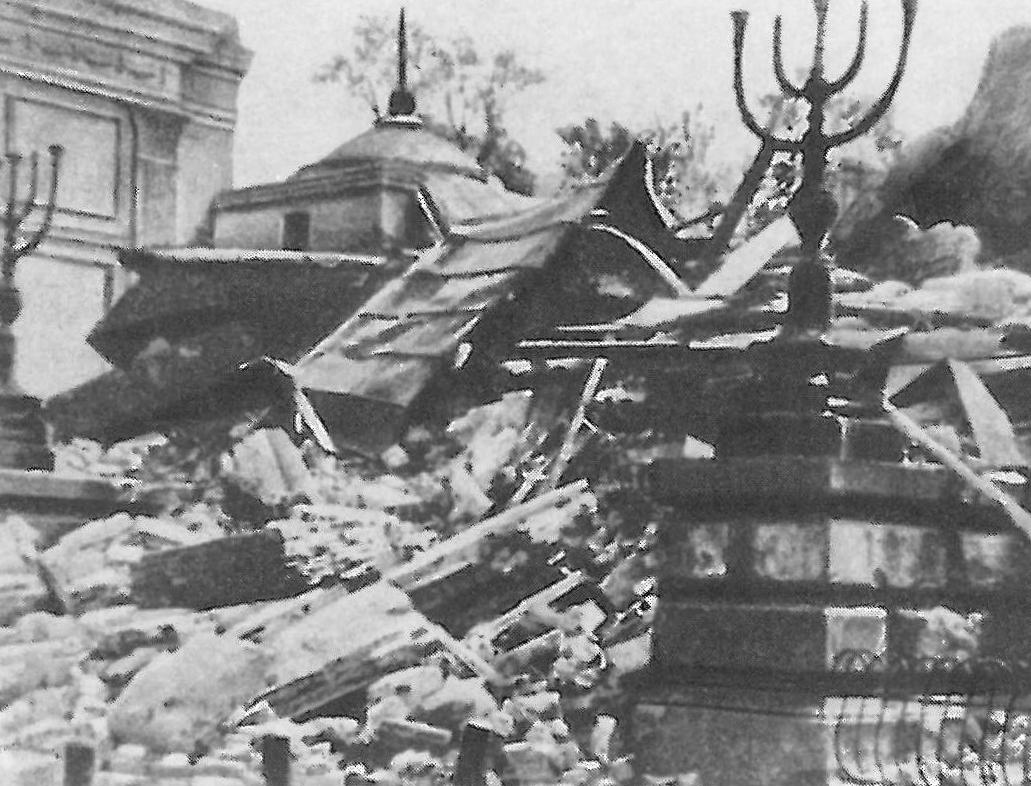 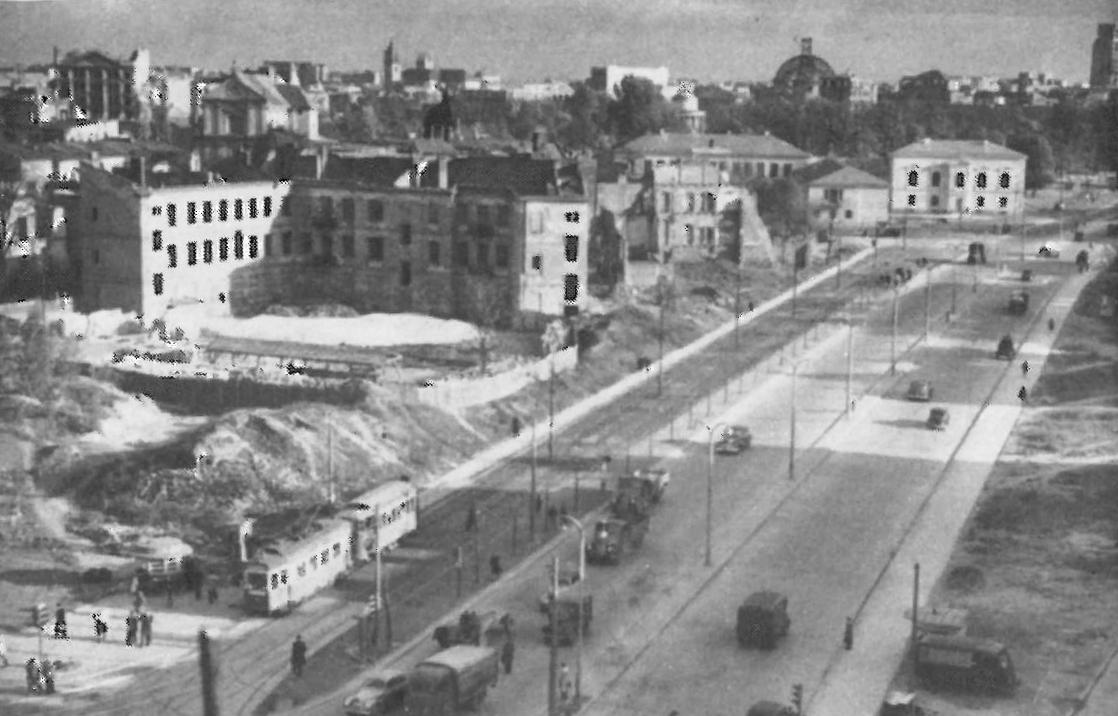 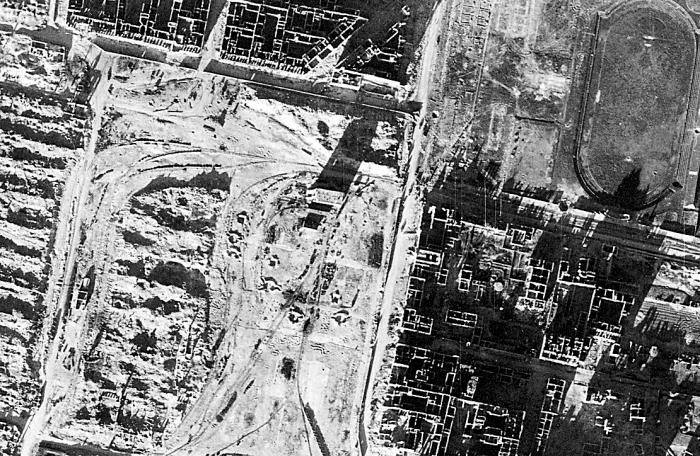  |
|
|
|
Post by jeanne on May 16, 2016 21:31:26 GMT 1
How sad that such a beautiful building was destroyed and not rebuilt. Personally, I would prefer a building with both the same prior purpose(synagogue)and the lovely architecture to the blue skyscraper...but no one asked my opinion...  |
|
|
|
Post by crazyhorse1 on May 17, 2016 20:32:03 GMT 1
It was only a building. The German Nazi could not totally eradicate the Jews. In fact they failed miserably as the State of Israel stands strong today. And, Germany has great difficulties with their new visitors. Some would say that's justice.
|
|
|
|
Post by jeanne on May 17, 2016 20:54:53 GMT 1
It was only a building. The German Nazi could not totally eradicate the Jews. In fact they failed miserably as the State of Israel stands strong today. And, Germany has great difficulties with their new visitors. Some would say that's justice. I agree...and you are right...it was only a building. But I was speaking on two levels: first, it is sad to see the demise of the beautiful building, and second, it's sad a synagogue was not rebuilt on that spot. If so many other buildings in Warsaw were rebuilt to the original specifications, then perhaps the synagogue should also have been. That also, would have been justice. Perhaps Bonobo can tell us if it was ever rebuilt at a different location? |
|
|
|
Post by Bonobo on May 19, 2016 20:05:55 GMT 1
It was only a building. The German Nazi could not totally eradicate the Jews. In fact they failed miserably as the State of Israel stands strong today. And, Germany has great difficulties with their new visitors. Some would say that's justice. I agree...and you are right...it was only a building. But I was speaking on two levels: first, it is sad to see the demise of the beautiful building, and second, it's sad a synagogue was not rebuilt on that spot. If so many other buildings in Warsaw were rebuilt to the original specifications, then perhaps the synagogue should also have been. That also, would have been justice. Perhaps Bonobo can tell us if it was ever rebuilt at a different location? I know nothing about a different location. Yes, I agree with you, rebuilding the synagogue would have been an act of justice and a symbol of resistance to evil, created by fascists. But I can also understand the reality of the times. The Jewish population of Warsaw had ceased to exist and those few who survived were mostly assimilated non-believers (also members of new communist authorities) who didn`t need a synagogue. I can even suspect they were against rebuilding it. |
|
|
|
Post by Bonobo on May 19, 2016 20:20:40 GMT 1
Great Synagogue in Gdańsk
The Great Synagogue (German: Neue Synagoge, Polish: Wielka Synagoga), was a synagogue of the Jewish Community of Danzig in the city of Danzig, Germany (later Free City of Danzig, now Gdańsk, Poland). It was built in 1885-1887 on Reitbahnstraße, now Bogusławski Street. It was the largest synagogue in the city, and was demolished by the Free City authorities in May 1939.
The synagogue was built in the Neo-Renaissance style on the basis of a long rectangle. It was one of the most distinctive buildings in Danzig, with its large dome, two towers and a lantern seen at night. In the middle of a front row there was a large stained glass window with the Star of David, and all spires were topped with meshed Stars of David.
The spacious interior was topped with a sail vault, from which enormous chandeliers were hung. The main chamber was located underneath the dome. The Aron Kodesh ark was on a pedestal behind a parokhet curtain in an apse. Above the ark, the tables of the Decalog were supported by two stone lions. Behind it were large organs and the choir of 100 members. The bimah was behind the pedestal.
Over 2000 people could participate in the services. In the main chamber there were two rows of benches for over 1600 people. Along the sidewalls and over the western entrance there were massive arcade galleries for over 300 women, supported by multi-sided pillars. The walls were decorated with motifs of plants, geometric symbols and Biblical verses. The entire synagogue had electric heating and lighting, relatively uncommon in the late 19th century.
History
The synagogue was financed by the five reform communities: Altschottland (modern Stary Szkoty), Weinberg (modern Winnicka), Langfuhr (modern Wrzeszcz), Danzig-Breitgasse (modern Szeroka) and Danzig-Mattenbuden (modern Szopy). It was built by a company from Berlin, Ende and Boeckman, chosen by the city council.
It was opened with a ceremony on 15 September 1887, by the Danzig rabbi Kossman Werner, in the presence of the city council and the faithful. The scrolls of Torah were transported in from the Old Synagogue and two other synagogues (the Great Synagogue was seen as a building uniting the Danzig Jews), placed in the Aron Kodesh and the Eternal Light was lit. The first service was held on 8 December 1887.
At the beginning of the 20th century the synagogue became one of the most notable centres of Reform Judaism. A large museum of Judaism contained many rare and old items, particularly the collection of Lesser Giełdziński. Many concerts were held here, and rabbis and professors from all around the world gave lectures.
The 1920s saw the rising anti-Semitism and the increasing strength of the Nazi Party in Germany. Danzig was closely tied to Germany, from which it was officially separated by the Treaty of Versailles, and it became an increasingly unpleasant place for Jews, particularly after March 1933, when the local Nazi party won control of the city government. The synagogue thereafter was a target of two arson attempts. Both were stopped by a local militia formed by the local Jewish population to protect the building in concert with the Danzig police, who feared that any negligence of the attacks on Jews would lead to a Polish intervention.[1] While the Constitution of the Free City of Danzig offered Danzig Jews greater protection than their brethren in Germany, Nazi sympathizers invaded the synagogue in August 1938 and trampled the Torah scrolls. The communities' leaders decided to safeguard some of their relics — the archives were shipped to Jerusalem, the library to Vilnius, and the museum to the United States. At the same time, mounting fiscal pressure forced the synagogue to sell the organs to Kraków, candlesticks to Warsaw, and the benches to Nowy Port. This was not enough, and in early 1939 the synagogue was sold to the senate of Danzig. On 15 April 1939, the last service was held in the building, and soon thereafter the senate took control. A banner was hung on a fence surrounding the building with the text: "Come, lovely May, and free us from the Jews". On 2 May, the Nazi-dominated government began demolishing the building.
After the German invasion of Poland on 1 September 1939, Nazi troops moved into the city, eradicating any resistance and claiming the city for Germany. During the Second World War most of the Jews of Danzig died in the Holocaust. Survivors mostly left Europe to settle in Israel.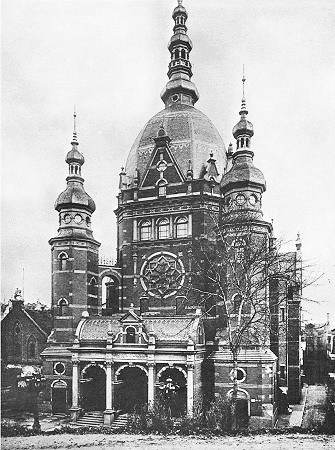     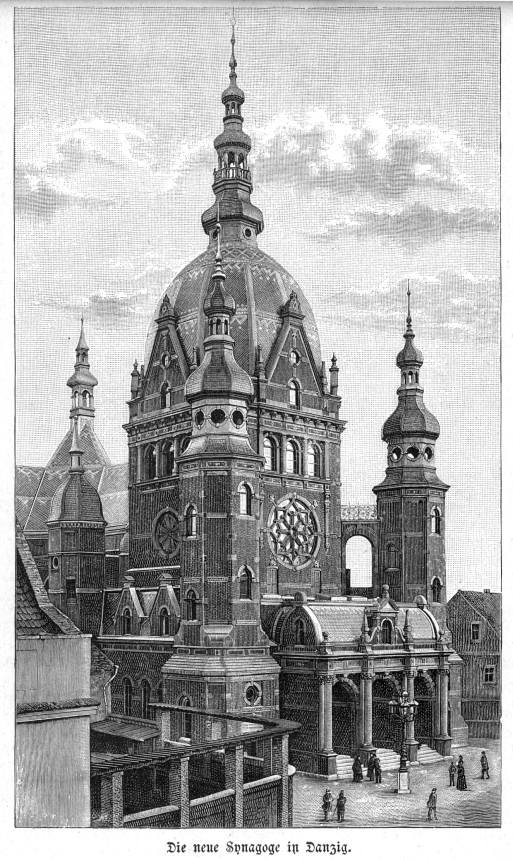 Demolition. German banner: Come, sweet May and free us of the Jews  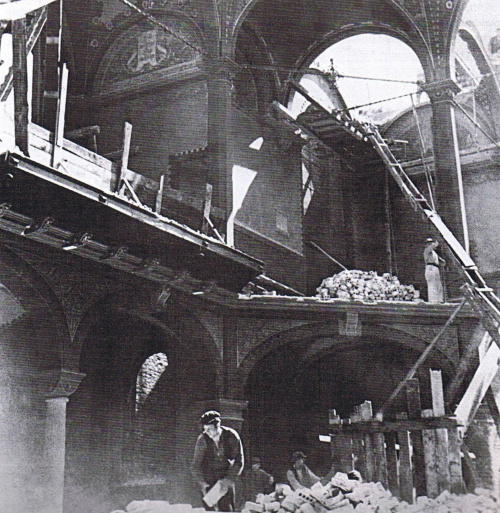 The area today - Elisabethan Theatre. 
|
|
|
|
Post by jeanne on May 19, 2016 20:37:49 GMT 1
But I can also understand the reality of the times. The Jewish population of Warsaw had ceased to exist and those few who survived were mostly assimilated non-believers (also members of new communist authorities) who didn`t need a synagogue. I can even suspect they were against rebuilding it. Yes, I do understand the reasons for it not being rebuilt, but the Blue Skyscraper looks to me to be modern enough to be built in our times when hopefully people generally are more enlightened and would see the good in rebuilding a synagogue there even if necessary on a much smaller scale. Like we all said, for justice sake. |
|
|
|
Post by jeanne on May 19, 2016 20:40:42 GMT 1
Great Synagogue in Gdańsk
The Great Synagogue (German: Neue Synagoge, Polish: Wielka Synagoga), was a synagogue of the Jewish Community of Danzig in the city of Danzig, Germany (later Free City of Danzig, now Gdańsk, Poland). It was built in 1885-1887 on Reitbahnstraße, now Bogusławski Street. It was the largest synagogue in the city, and was demolished by the Free City authorities in May 1939. This one was even more beautiful than the one in Warsaw!  (at least on the outside...) |
|
|
|
Post by Bonobo on May 27, 2016 22:58:28 GMT 1
|
|
|
|
Post by Bonobo on May 27, 2016 23:12:05 GMT 1
Old Synagogue in Łódź - burnt by Germans in 1939. The Stara Synagogue was a "beautiful"[1] synagogue in Łódź, Poland. The name Stara means old, many Polish cities called the oldest synagogue in town the Stara synagogue. The Stara was Łódź's principal Orthodox synagogue. It was built by Orthodox industrial magnates who wished to outshine, or at least compete with, the 1881 Great Synagogue (Łódź) built by the Reformed Jewish community.[2]
History
Łódź, a village of fewer than 200 people at the end of the eighteenth century, developed rapidly into a great industrial city. Łódź's first synagogue, a wooden building, was built in 1809 at 8 Wolborska Street. The land was purchased from a lieutenant in the National Guard named Józef Aufschlag. By 1854 the building was in such poor condition that it was condemned by town authorities. Services are known to have continued thorough 1861 despite the official condemnation.[3]
Work began in 1859 on a new, brick synagogue at 20 Wolborska Street designed by Jan Karol Mertsching in a neo-mannerist style. The new building opened in 1861. Construction, slowed by a financial crisis, continued until 1871.[4][5]
The 1861 building was replaced between 1897 and 1900 by an elaborate Moorish Revival synagogue designed by Adolf Zeligson, a well-known Łódź architect. The architect's signed plans for the building were auctioned at Sotheby's on December 17, 2008 for $13,750.[6]
According to Shimon Huberband (1909–1942), who documented the response of religious Jews of Poland to the Holocaust before he was murdered by the Nazis: "The synagogue was very tall and beautiful. It contained two women's galleries. In all, it held fifteen hundred seats. There were thirty-six Torah scrolls in the synagogue and a large amount of silver Torah ornaments, including many antique works of art. All official public ceremonies took place in this synagogue".[7]
The synagogue was burned to the ground on November 15–16, 1939 during the Nazi occupation 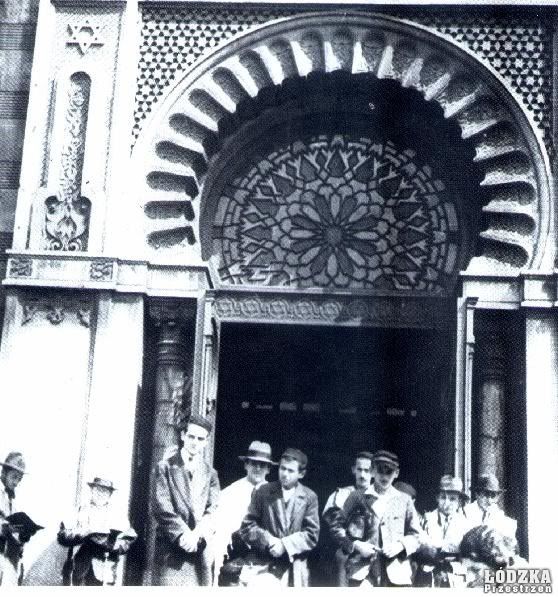 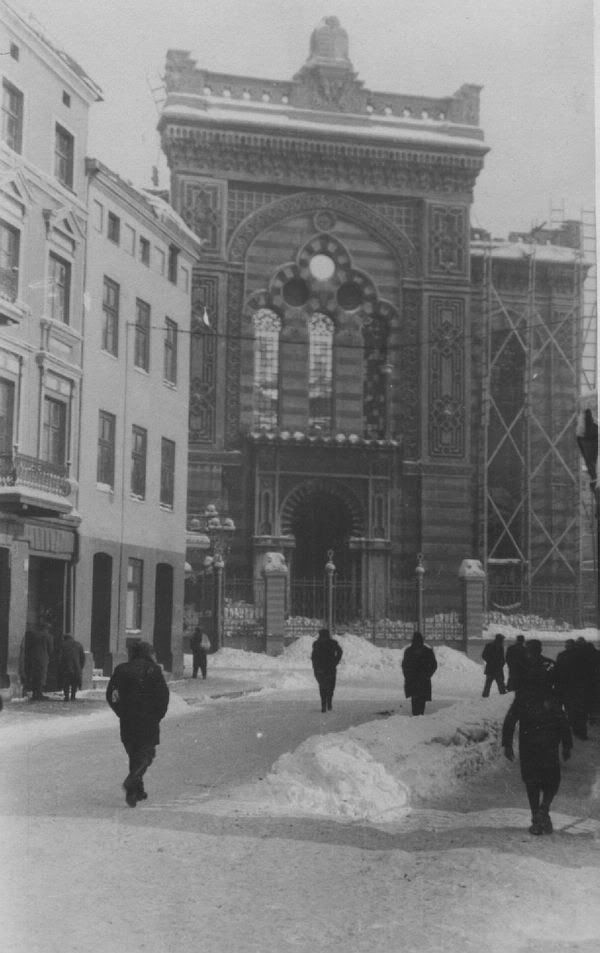   Today`s monuments  Moses   |
|
|
|
Post by jeanne on May 28, 2016 0:37:31 GMT 1
I have read a lot about the holocaust...I am, of course, aware of the murder of millions of Jews, the destruction of their homes, businesses, and synagogues, but seeing the graphic images of these beautiful buildings (which they loved and which were such an integral part of their lives) lying in ruins just really speaks to me in a very deep way of the unspeakable horror, cruelty and inhumanity of it all. Heartbreaking...
|
|
|
|
Post by pjotr on May 29, 2016 15:19:25 GMT 1
How sad that such a beautiful building was destroyed and not rebuilt. Personally, I would prefer a building with both the same prior purpose(synagogue)and the lovely architecture to the blue skyscraper...but no one asked my opinion...  I agree with you Jeanne, eventhough I love the skyscrapers in Warsaw too, because they are the symbol of Poland's resurrection after Nazism and Communism. I would have loved the Synagogue to have been rebuilt and standing at that place again. It was a wonderful shul. Almost as beautiful as the Berlin and Budapest shuls.  Berlin Alt-neu synagogue Berlin Alt-neu synagogue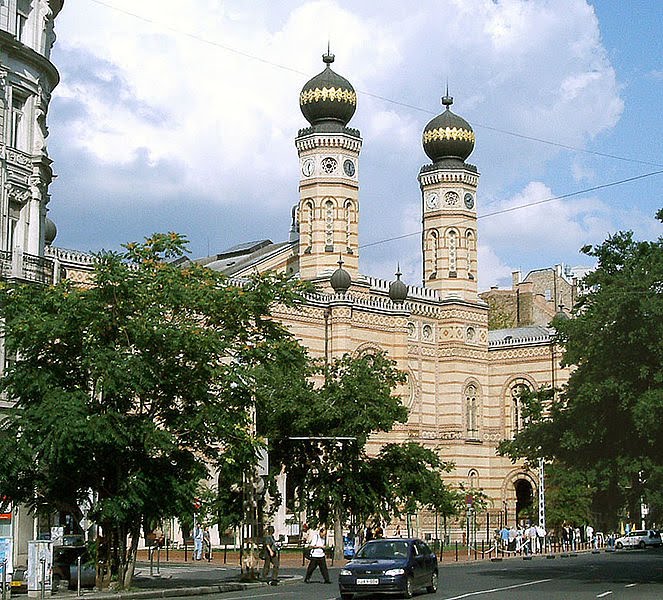 Budapest Synagogue Budapest Synagogue |
|
|
|
Post by pjotr on May 30, 2016 15:40:45 GMT 1
The area today - Elisabethan Theatre.     Where you once had that wonderful Neo-Renaissance Great Synagogue (German: Neue Synagoge, Polish: Wielka Synagoga), you know have that rather ugly new theatre, in a sort of artificicial architecture you saw all over Europe during the fitties, sixties, seventies and eigthies. Nice try, but in the shadow of the memory of that Great Synagogue. The theatre might be functional and modern from the inside, from the outside it looks like a prison, or the headquarters of the Dark Side of the Force.   I wish they had rebuilt that wonderful shul.  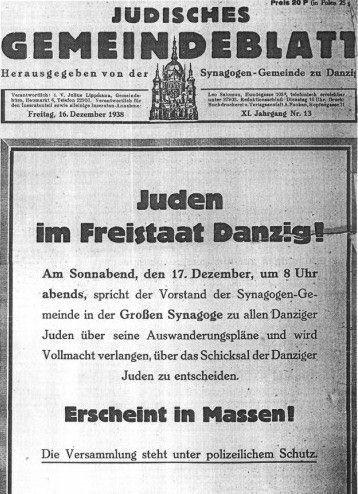 This statement in German to the jews of Gdansk (Dantzig in that time) calls the jews of the community to a gathering under police protection. There will be spoken about immigration plans. This statement in German to the jews of Gdansk (Dantzig in that time) calls the jews of the community to a gathering under police protection. There will be spoken about immigration plans. |
|
|
|
Post by pjotr on May 30, 2016 15:48:45 GMT 1
The Stara Synagogue in Łódź, Poland was burned to the ground on November 15–16, 1939 during the Nazi occupation  This shows what a barbarians the Nazi's were. Civilized people don't destroy houses of worship, symbols of civilization and hallmarks of a city. The city of Gdańsk is less beautiful without this beautiful synagogue in Bo's words. Like many cities and towns are less beautiful in Europe, because synagogues and churches were destroyed and disappeared. |
|
|
|
Post by pjotr on May 30, 2016 16:02:10 GMT 1
 A Syngagogue of Poznan before the war A Syngagogue of Poznan before the war 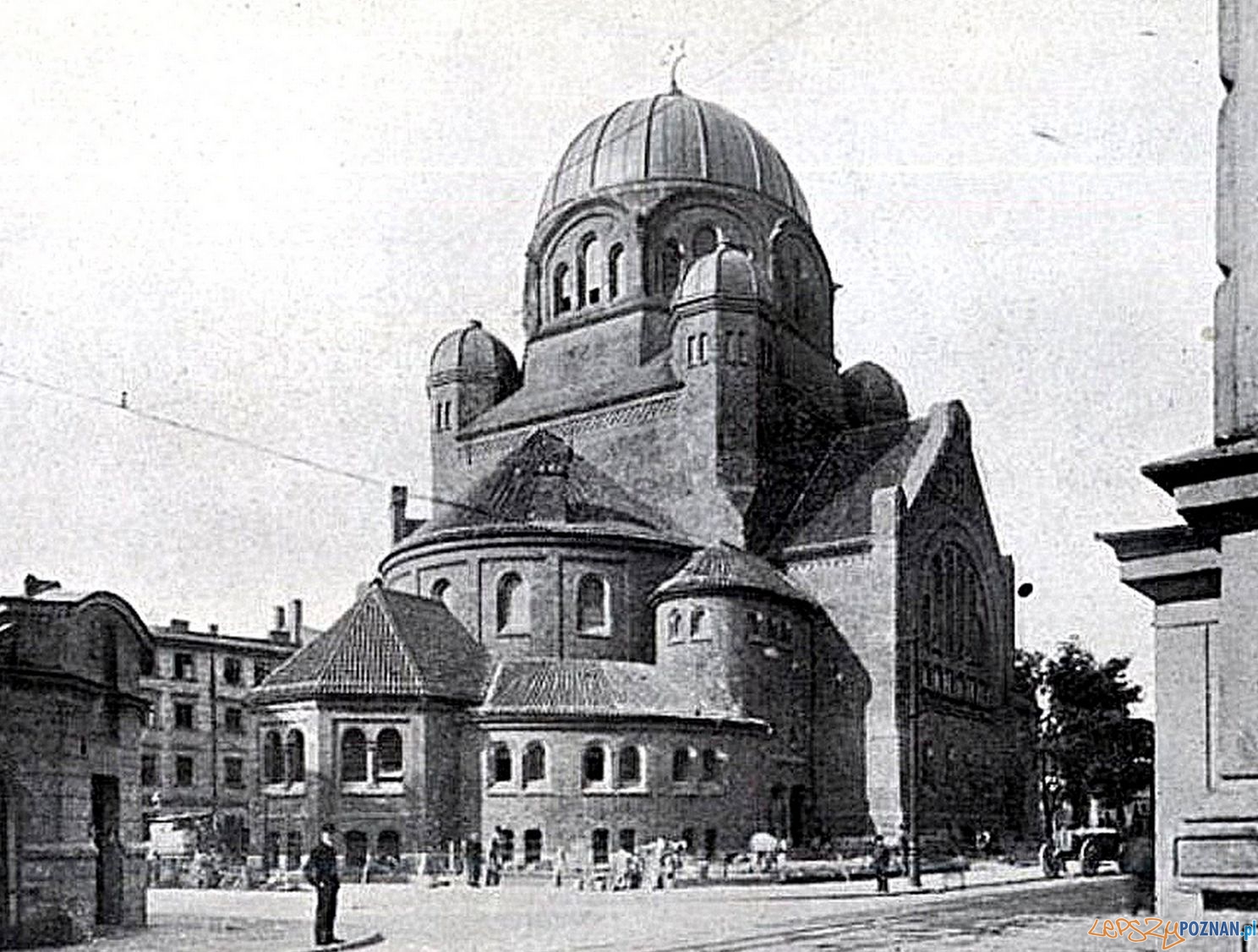 Old Jewish Synagogue in PoznanThe Nazis transformed the Great Synagogue in Poznan, Poland, into a pool. Old Jewish Synagogue in PoznanThe Nazis transformed the Great Synagogue in Poznan, Poland, into a pool.
The Synagogue – Wroniecka Street, near Stawna Street, Małe Garbary and the extension of Żydowska Street. The construction plans were made in 1902. The corner stone was set on 6th May 1906. The construction was completed on 5th May 1907. The last service was conducted on 9th September 1939. In 1941 the Nazis transformed the synagogue into a swimming pool for Wehrmacht soldiers and it is still used for that purpose nowadays. In 2003 the Jewish community took over the property right to the building.[1.1]



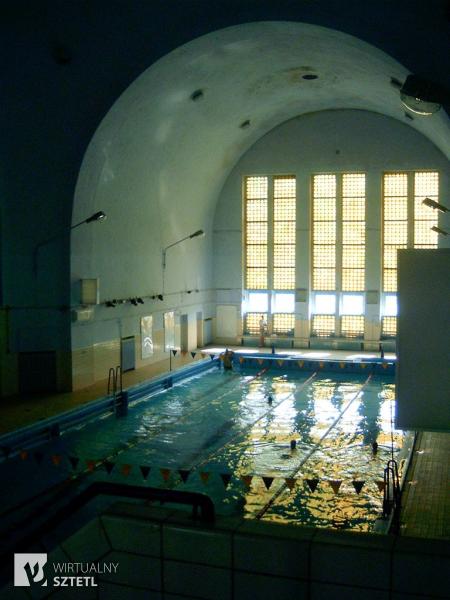
sztetl.org.pl/en/towns/p/586-poznan/112-synagogues-prayer-houses-and-others/88009-synagogue-wroniecka-st
|
|
|
|
Post by pjotr on May 30, 2016 16:15:23 GMT 1
Great Synagogue, Białystok The Great Synagogue The Great Synagogue (Polish: Wielka Synagoga w Białymstoku) was a synagogue located in Białystok, Poland, which was built between 1909-1913 and designed by Szlojme Rabinowicz. The synagogue was burnt down by German Nazi's on J une 27, 1941, with an estimated number of 2,000 Jews inside. History The synagogue The synagogue was located on Suraska Street. Construction began in 1909 and the building was completed in 1913. It was designed by Szlojme (Shlomo) Jakow Rabinowicz. The design included three Byzantine style domes: a large one with a ten-meter spire over the main hall with two smaller ones flanking it over the side halls. On the morning of June 27, 1941, Nazi troops from Order Police ( Ordnungspolzei) Battalion 309 surrounded the town square by the Great Synagogue, and forced residents from their homes into the street. Some were shoved up against building walls and shot dead. Others– some 2,000 men, women and children– were locked in the synagogue, which was subsequently set on fire; there they burned to death. The Nazi onslaught continued with the grenading of numerous homes and further shootings. As the flames from the synagogue spread and merged with the grenade fires, the entire square was engulfed. On that day some 3,000 Jews lost their lives.
|
|
|
|
Post by pjotr on May 30, 2016 16:59:58 GMT 1
The Golden Rose Synagogue in Lwów The Golden Rose Synagogue The Golden Rose Synagogue, known also as the Nachmanowicz Synagogue, or the Turei Zahav Synagogue (Hebrew: בית הכנסת טורי זהב) was a synagogue in Lwów ( Lemberg in Yiddish), Poland. The Golden Rose Synagogue was the oldest synagogue in Poland. HistoryA midtown plot of land was bought in 1580, and the synagogue was founded and funded in 1581 by Yitzhak ben Nachman (alias Izak Nachmanowicz), a financier to King Stephan Batory. Therefore, the oldest name of the synagogue was the Nachmanowicz Synagogue. It was built in 1582 by Paulus Italus (" Paolo the Italian") from Tujetsch (Tschamut) village in canton Graubünden, Switzerland, a master builder known by his guild nickname Paweł Szczęśliwy ( Paul the Fortunate, in Polish). In 1595, the same Paolo, assisted by Ambrogio Nutclauss (alias Ambroży Przychylny), by Adam Pokora, and by master Zachariasz (most probably, Zachariasz Sprawny, alias Zaccaria de Lugano) built a vestibule and a women’s gallery in the synagogue. Men prayed in a hall which was spanned by a cloister rib vault with pointed lunettes above the windows. An alabaster Torah ark in renaissance style was located at the eastern wall. A bimah was located in the middle of the prayer hall. The building was topped by an attic in Mannerist style. In 1606 the building was confiscated by the Jesuits. In 1609, after paying a ransom of 20,600 guilders the synagogue was returned to the Jewish community. A local legend (first published in 1863) ascribed the merit of the restitution of the synagogue to Rosa bat Ya'akov, Yitzhak's daughter-in-law. The synagogue was therefore also called the Golden Rose Synagogue after her. Rabbi Yitzhak ben Shemuel HaLevi composed in 1609 Shir Ge'ula (a Song of Deliverance), – which was read each year as a part of the shacharit prayer on Shabbat following Purim. The Song of Deliverance compared the return of the synagogue to the Jewish community to the salvation of the Jews from the Babylonian and Egyptian captivities. In 1654-67, rabbi David HaLevi Segal, called TaZ after his main work Sefer Turei Zahav, the younger brother of Yitzhak HaLevi and his pupil, prayed in this synagogue. For that reason the building was also named the TaZ Synagogue.  David ha-Levi Segal (c. 1586 – 20 February 1667), also known as the Turei Zahav (abbreviated Taz (ט"ז)) after the title of his significant halakhic commentary on the Shulchan Aruch, was one of the greatest Polish rabbinical authorities. David ha-Levi Segal (c. 1586 – 20 February 1667), also known as the Turei Zahav (abbreviated Taz (ט"ז)) after the title of his significant halakhic commentary on the Shulchan Aruch, was one of the greatest Polish rabbinical authorities. ( en.wikipedia.org/wiki/David_HaLevi_Segal / www.jewishencyclopedia.com/articles/4979-david-b-samuel-ha-levi ) In 1941, the synagogue was desecrated, and in 1943 ruined by the Nazis. There is a plaque which commemorates the Golden Rose Synagogue: " Remnant of the old temple called 'Di Goldene Royz'. Built during 1580-1595 by the Nachmanowicz family in the memory of Nachmanowicz's wife. The building designed by the Italian architect Pablo Romano was destroyed by Nazis and burnt in summer 1942." The members of the Jewish community of Lviv desire a reconstruction of the synagogue “as it once was”. ConservationThe synagogue was designated a World Heritage Site in 1998. The article by Tom Gross published in The Guardian's " comment is free" section on September 2, 2011 under the headline " Goodbye Golden Rose" reported that the authorities in Lviv, contrary to Ukraine's laws designed to preserve historic sites, were allowing a private developer to demolish parts of the adjacent remnants of the synagogue complex in order to build a hotel, which would endanger the mikvah and other Jewish artifacts, as well as possibly the remaining outer walls of the synagogue itself. Lviv officials refuted that information. Reacting to international pressure generated by Gross's article, and by pressure from the Ukrainian president's office in Kiev, the city authorities ordered a halt to the hotel work in order to preserve the Jewish artifacts and to ensure the synagogue's outer walls would not be threatened. The mayor of Lviv also announced the city would proceed with long-delayed plans to build a Holocaust memorial near the Golden Rose synagogue in the former Jewish quarter of Lviv's old town. In July 2015 the Center for Urban History of East Central Europe started work on their Space of Synagogues project. Working with a range of organisations on the memorialisation of the Synagogues of Lviv, the Center's project will contribute significantly to the conservation of the remains of the Synagogue. 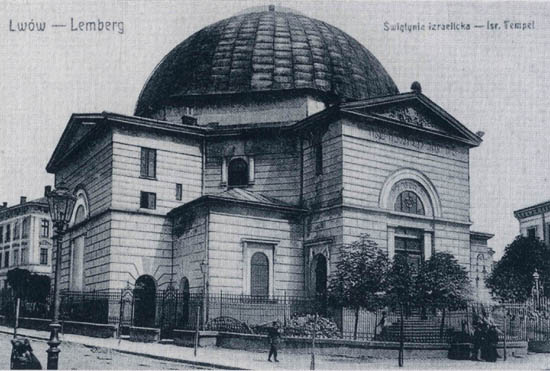 Another synagogue in pre-war Lwów Another synagogue in pre-war LwówJason Francisco, an artist, essayist, curator, and educator who photographed and wrote about Lviv (Lwów) wrote: The ancient jewish district along staroevreiska street visibly displays the several senses in which non-action expresses a form of remembrance. immediately adjacent to each other, you find the following: a plaza at the site of the former great city synagogue, beside an open field at the site of the former beit midrash, beside the ruins of the gold rose. each of these sites has remained unbuilt since the nazis destroyed the buildings, which is to say the city has kept these sites as holes. that inaction should not be taken as meaningless. there is, currently, a stalled plan for proper preservation and commemoration––an international competition described on laminated placards mounted to a corrugated metal fence, which happen also to provide the most complete public historical account of jewish life in the city. in the latest phase of meaning-laden inaction, the plan has gotten mired in civic and jewish communal politics, and may or may not go forward. the ruins of the golden rose currently look like this, in a stitched panorama i made from the window of a nearby building.   In the near future this place will be a quiet, authentic, respectful place of remembrance on the remains of the Golden Rose. In the near future this place will be a quiet, authentic, respectful place of remembrance on the remains of the Golden Rose.
|
|
|
|
Post by jeanne on May 30, 2016 17:35:00 GMT 1
The area today - Elisabethan Theatre.   Where you once had that wonderful Neo-Renaissance Great Synagogue (German: Neue Synagoge, Polish: Wielka Synagoga), you know have that rather ugly new theatre, in a sort of artificicial architecture you saw all over Europe during the fitties, sixties, seventies and eigthies. Nice try, but in the shadow of the memory of that Great Synagogue. The theatre might be functional and modern from the inside, from the outside it looks like a prison, or the headquarters of the Dark Side of the Force.   I wish they had rebuilt that wonderful shul. Pieter, These are my sentiments also! To me the theatre is ugly...I like your term "artificial architecture! Thanks for posting all this information. There is so much info that it is difficult to comment on, so suffice it to say that I appreciate your efforts in posting. Also, "The Pianist" is one of my favorite films, and I thought you did a great job with the video on "Dit Is Arnhem;" I didn't understand what was being said, but I learned a lot from the images you presented...nicely done. Oh, and the pre-war films were excellent. They were of surprisingly good quality. And, I was amazed that there is actually a surviving film with Anne Frank in it, albeit short, but still amazing! Jeanne |
|
|
|
Post by pjotr on May 31, 2016 16:55:02 GMT 1
Synagoga w Głogowie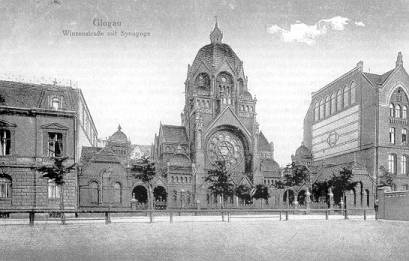 Synagoga w Głogowie (niem. Synagoge in Glogau) – największa synagoga głogowskiej gminy żydowskiej, znajdująca się przy obecnej ulicy Hugona Kołłątaja, dawnej Wingenstraße. Miała w założeniu stanowić ważną dominantę w krajobrazie miasta i świadczyć o randze tutejszej gminy żydowskiej. Była uważana za jedną z najpiękniejszych synagog w Niemczech. W 1891 roku nastąpiło uroczyste położenie kamienia węgielnego pod budowę nowej synagogi. Inspiracją berlińskich architektów Hansa Abessera i Jürgena Krögera była monachijska synagoga. Uroczyste otwarcie synagogi nastąpiło we wrześniu 1892 roku. Podczas nocy kryształowej z 9 na 10 listopada 1938 roku, bojówki hitlerowskie splądrowały i spaliły synagogę. Wkrótce jej zgliszcza rozebrano do fundamentów.  Murowany budynek synagogi wzniesiono na planie zbliżonym do prostokąta, w mieszanym stylu neogotyckim, eklektycznym oraz neorenesansowym. Jej najbardziej charakterystycznym elementem był trzon, który stanowił masywną i wysoką na 32 metry część wieżową, zwieńczoną wielką kopułą. Po bokach znajdowały się parterowe przybudówki zwieńczone kopułami, w których znajdowały się wejścia boczne. Cała synagoga mogła pomieścić 300 mężczyzn i 250 kobiet. W 55. rocznicę spalenia synagogi odsłonięto w Głogowie pomnik poświęcony pamięci społeczności żydowskiej tego miasta. Monument - miejsce pamięci (proj. inż. arch. Dariusza Wojtowicza) tworzą: zrekonstruowany na oryginalnych fundamentach synagogi obrys jej murów oraz niewielki obelisk z inskrypcjami w językach polskim i hebrajskim: "Pomnik ten wzniesiony przez mieszkańców Głogowa w uznaniu wiekopomnych zasług wspólnoty żydowskiej i jej ostatniego duchowego przywódcy Rabina Dr Leopolda Lucasa dla rozwoju społeczno-kulturalnego miasta, znajduje się w miejscu zbezczeszczonej przez Nazistów w 1938 roku synagogi i upamiętnia tragedię Żydów mieszkających na tym terenie ponad 700 lat aż do wysiedlenia w 1942 roku. Rada Miejska w Głogowie". 
|
|
|
|
Post by pjotr on May 31, 2016 17:04:01 GMT 1
|
|
|
|
Post by pjotr on May 31, 2016 17:20:34 GMT 1
 Where you once had that wonderful Neo-Renaissance Great Synagogue (German: Neue Synagoge, Polish: Wielka Synagoga), you know have that rather ugly new theatre, in a sort of artificicial architecture you saw all over Europe during the fitties, sixties, seventies and eigthies. Nice try, but in the shadow of the memory of that Great Synagogue. The theatre might be functional and modern from the inside, from the outside it looks like a prison, or the headquarters of the Dark Side of the Force.   I wish they had rebuilt that wonderful shul. Pieter, These are my sentiments also! To me the theatre is ugly...I like your term "artificial architecture! Thanks for posting all this information. There is so much info that it is difficult to comment on, so suffice it to say that I appreciate your efforts in posting. Also, "The Pianist" is one of my favorite films, and I thought you did a great job with the video on "Dit Is Arnhem;" I didn't understand what was being said, but I learned a lot from the images you presented...nicely done. Oh, and the pre-war films were excellent. They were of surprisingly good quality. And, I was amazed that there is actually a surviving film with Anne Frank in it, albeit short, but still amazing! Jeanne Dear Jeanne, I could have not filmed Dit is Arnhem without the input I received, the books I read, the documentaries I saw, the images on these two Polish Culture Forums before, and my travels to Poland (the synagogues of Krakow and Warsaw which I saw there), Prague, Budapest, the wonderful Alt-neu synagogue of Berlin, reading 'Jerusalem of the West of Siegfried van Praag', the soul of my jewish friends and their stories about shuls and shabats, my visits to the Portuguese synagogue in Amsterdam and the Jewish Historical Museum there. I tried to do my best to film from every angle and corner and the basic elements and atmosphere of the mosque. And imagined a full synagogue with the pre-war congregation. I would not have posted all this information and put so much effort in it if Bonobo wouldn't have started this incredible interesting thread about the heritage of the Polish jews and their houses of Worship in various Polish cities. By showing this, serching, finding and posting this information we show Polish and jewish history in Poland. Because Poland was and is built by it's Roman-Catholic majority, but also by it's Polish Jewish, Lutheran Protestant and Roman-Catholic German, Orthodox christian Ukrainian and other minorities and even some Dutch Mennonites and Calvinists (today Polish Calvinists). Cheers, Pieter |
|
|
|
Post by pjotr on May 31, 2016 17:42:31 GMT 1
Radom Synagogue  General view of the original Radom Synagogue based on historical records, rendering from 1987 General view of the original Radom Synagogue based on historical records, rendering from 1987The Radom Synagogue was an Orthodox Synagogue in Radom, Poland, destroyed by Nazi Germany following the invasion of Poland in World War II. The Synagogue was located at Podwalna Street, previously named the Bożnicza Street. It was built in 1846, and burned to the ground in 1939 when the Radom Ghetto was set up. 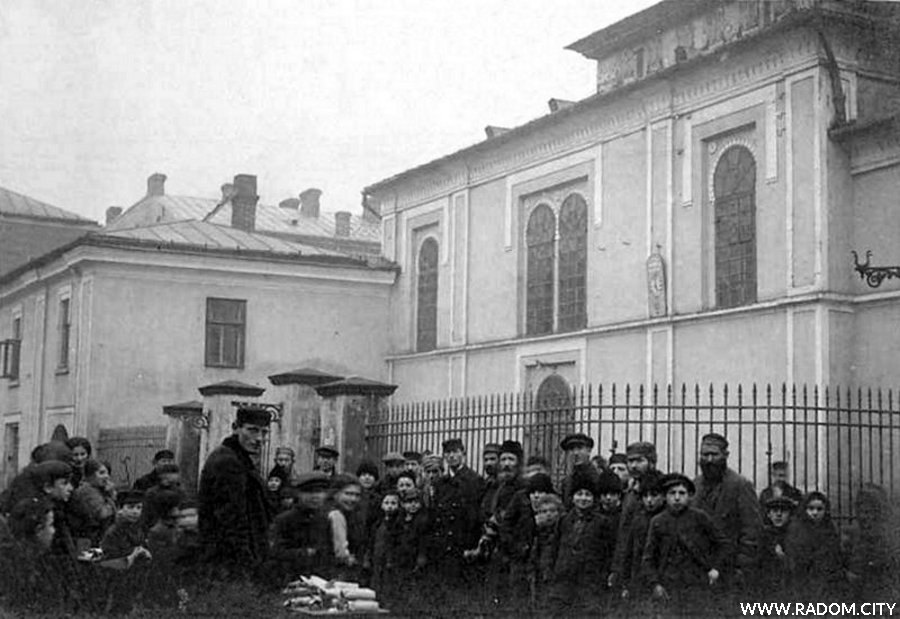 Almost all Radom Jews perished during the Holocaust in occupied Poland Almost all Radom Jews perished during the Holocaust in occupied Poland resulting in nearly complete abandonment of the site. After the end of war, the ruins of the Synagogue were dismantled on the orders of the local pro-Soviet communist government.  Remnants of Radom Synagogue right after its Nazi German destruction Remnants of Radom Synagogue right after its Nazi German destruction
|
|
|
|
Post by pjotr on May 31, 2016 17:51:59 GMT 1
The Jewish synagogue in Toruń
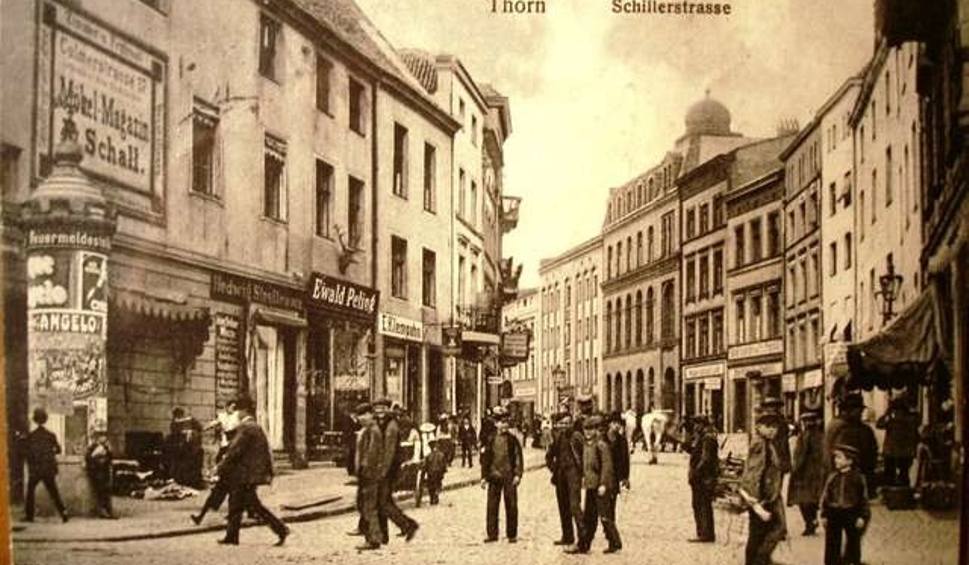
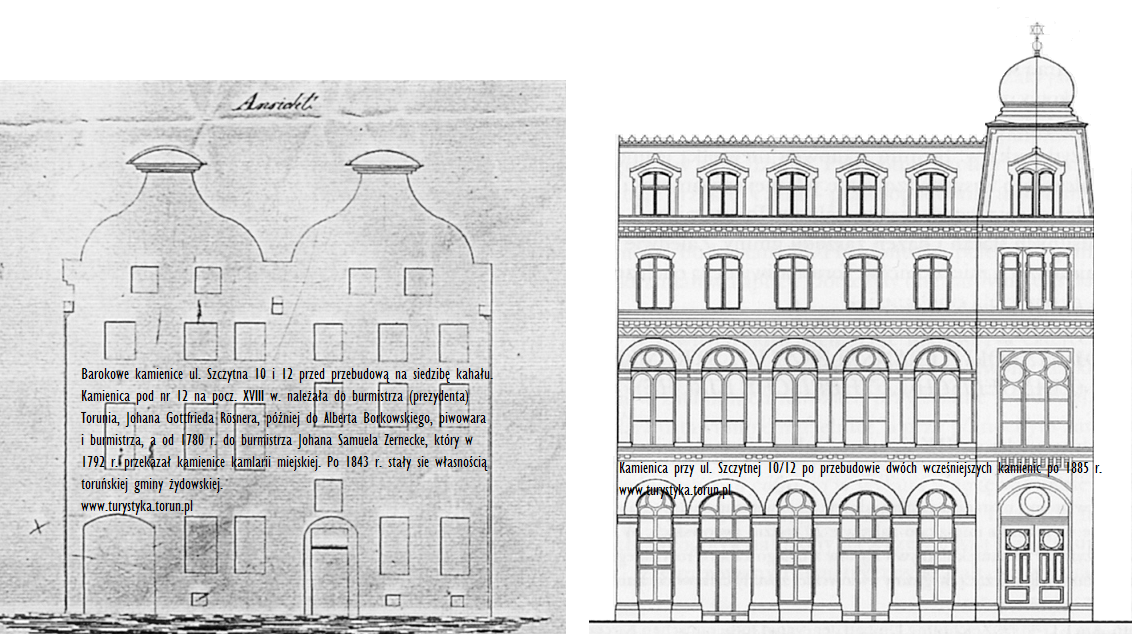
The Jewish community in Toruń was very active before World War II. Just before the Nazi German invasion of Poland, Jews supported the Polish government fund-raising for Air Defence (Dz.U.R.P.Nr 26, poz. 176) much more generously than average Torunians. The German army entered the city on September 7, 1939. By the end of November the city was declared Judenfrei, with several hundred Jews who chose to stay, deported to the Łódź Ghetto and other locations in the Warthegau. Nazi Germany annexed the city, and administered it as part of Danzig-West Prussia. Poles were classified as Untermenschen by German authorities (just like the jews), with their fate being slave-labor, executions and expulsions (which we today call ethnic cleansing).
 The Hebrew Institute in Toruń The Hebrew Institute in Toruń
|
|
|
|
Post by pjotr on May 31, 2016 18:01:47 GMT 1
The synagogue of Gniezno Reform synagogue in Gniezno, circa 1920. Reform synagogue in Gniezno, circa 1920.GNIEZNO (Ger. Gnesen), city in Poland; first capital of Poland and center of the Catholic Church in that country until the beginning of the 14th century. Jews are mentioned there in 1267. Various charters of privilege granted to individual Jews or the community giving them rights of residence, and permission to organize defense and engage in commerce (1497, 1499, 1519, 1567, 1571, 1637, 1661) were destroyed in fires that periodically devastated the town. From the 13th to the middle of the 17th centuries, Gniezno Jewry remained one of the smaller communities in the kingdom, numbering 100 people in 30 houses at the end of the period. A representative from Gniezno participated in the provincial (galil) council of the communities of Great Poland in 1519. Several such councils were convened at Gniezno (in 1580, 1632, 1635, 1640, 1642). Local and visiting merchants and their agents dealt in wool and rags and collected tolls at the biannual fairs, and even attempted to carry on business outside the Jewish quarter (1643). The synagogue, built in 1582, was modeled after the one in Poznan. Eliezer *Ashkenazi was among the rabbis of Gniezno. The events surrounding the Swedish War (1655–59), as well as attacks led by the Jesuits and by the troops of Stephan *Czarniecki, ended with the destruction of the community. In 1661 it reorganized outside the city walls.  A new synagogue was built in 1680. In the first half of the 18th century the community suffered during the Northern War, and there was an outbreak of fire as well as cases of *blood libel (1722, 1738). There were 60 Jews living in Gniezno in 1744. The community increased from the second half of the 18th century, particularly after Gniezno came under Prussian rule with the second partition of Poland in 1793, growing from 251 in the beginning of the period to 1,783 in the middle of the 19th century. It had cultural and welfare institutions, craftsmen's associations, a school, and a synagogue. The talmudic scholar Moses Samuel *Zuckermandel officiated as rabbi in Gniezno from 1864 to 1869. Subsequently many Jews emigrated to the German states and from the second half of the 19th century to America, especially after Gniezno was incorporated within independent Poland in 1919. The community numbered 750 in 1913 and approximately 150 in the 1930s.  Holocaust Period Holocaust PeriodBefore World War II nearly 150 Jews lived in Gniezno. During the Nazi occupation, the town belonged to Warthegau. During the first four months of the occupation, the town was emptied of all its Jewish inhabitants. A certain number escaped before and after the Germans entered, but the majority were deported on orders given on Nov. 12, 1939, by Wilhelm Koppe, the Higher SS and Police Leader of Warthegau. The orders called for the deportation of the entire Jewish population of Gniezno by the end of February 1940 to the territory of the General-gouvernement. On Dec. 13, 1939, 65 Jews from Gniezno, probably the last of the community, arrived in Piotrkow Trybunalski in the Radom district. After the removal of the Jews from Gniezno, the Germans blew up the synagogue and razed the old Jewish cemetery, using it as the site of a warehouse. No Jews resettled in the town after World War II.
|
|
|
|
Post by pjotr on May 31, 2016 18:15:36 GMT 1
Lublin
The oldest settlements in the present area of Lublin date back to the 6th century AD. In the 9th century there was an important trade colony on the route between Western and Eastern Europe. In 1317 Lublin obtained Magdeburg civic rights. The city constituted royal property. In 1474 Lublin became the capital of the voivodeship which belonged to Malopolska. The l6th c. and the first half of the 17th c. were the times of the greatest cultural and economic development of the city. The union between Poland and Lithuania (the so-called Lublin union, 1569), concluded on the premises of the royal castle, and also the choice of Lublin as the seat of the Royal Tribunal for the Malopolska region strongly manifest the significance of the city at that time.
Due to its location and importance, the city constituted a national, religious and cultural mixture. Besides the Polish popalation there also lived Ruthenians, Jews, Germans, Italians, Frenchmen, Scots, Hungarians, Armenians. In the middle of the l7th c., during wars with Cossacks, Russia and Sweden, the city was seriously destroyed and lost its previous meaning. After Poland had lost its independence and got partitioned (1795), Lublin became a part of the Austrian empire and in 1815 a part of the Russian territory. After the First World War, in reborn Poland, Lublin - a city of middle size - was chosen as the capital of the voivodeship.
The oldest mention of the Jews settled in Lublin dates from the year 1330. In 1336 King Kazimierz Wielki granted them the privilige to settle down in the Podzamcze area. This fact was recalled by the seniors of the community in 1558. The l6th c. and the first half of l7th c. were times when the splendour of Lublin and Lublin community reached its peak. In the first half of the l6th c. the Lublin community was the third largest in the Kingdom of Poland (others were Cracow and Lvov) as for the number of inhabitants (350 families) and held the leading position with respect to cultural and economic development.
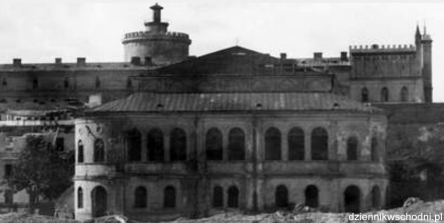  Interior of a pre-war Lublin synagogue Interior of a pre-war Lublin synagogue
German demolition

The townspeople of Lublin, afraid of Jewish merchants' competition, following the example of other royal towns, obtained from the King the privilege de non tolerandis Judaeis which forbade Jews to live freely within the borders of the city walls. Only a few Jews remaining in the king's service had the right to own houses. As a result, a separate Jewish colony emerged outside the city walls - in Podzamcze, on the northern slope of the castle hill. During the l6th c. the community obtained numerous privileges, above others to run trade, buy new lands and enlarge communal buildings (butcher's stalls, the hospital, the brick synagogue). In 1518 Shalom Shachna founded there a yeshiva which was famous all over Europe. According to the king's privilege from 1567 sages of the Lublin yeshiva obtained the title of rector and rights equal with those at other Polish universities. In 1547 the wandering printer Hayyim Schwartz was granted the privilege to establish a Hebrew printing house which was the first in Lublin. Like many other publishing houses it issued numerous works which played a significant role in the development of Jewish printing in Poland. In 1581 the Jewish Council of the Four Lands emerged (Va'ad Arba Aratsot) which existed until 1764. The main places of its conventions were Lublin and Jaroslaw. Lublin Jews performed many important functions there, including the post of the Speaker. During the invasion of Cossack and Muscovite armies (October 1655) the whole Podzamcze got almost completly burnt down and approximately two thousand Jews lost their lives. After that tragedy Jews started renting numerous estates within the boundaries of the Christian town, establishing shops and warehouses, which raised townsmen's protests. Jews' protectors taking advantage of the lease were the clergy and gentry. The Jewish town in Podzamcze was gradually getting rebuilt. In 1787 it had the population of about 3.5 thousand people. At the end of the 18th c. Lublin became the centre of Hasidism. At first the famous tzaddik Ya'akov Yitskhok Hurvits was active there, then his role was taken over by the dynasty of Eigers until the Holocaust.  In the towns of the Russian partition Jews were allowed to live only in the quarters assigned by the authorities: In Lublin it was the so-called sector II which also covered the area of Lubartowska St. - demarcated in the beginning of the l9th c. where a new Jewish district was slowly turning up. Only thanks to Wielopolski's reform (1862) the Jews gained the freedom to purchase civic real estates. Taking advantage of that right Jews soon bought out almost all houses within the borders of the Old Town. Some rich assimilated families also settled in the representative area of Krakowskie Przedmiescie St. During the l9th c. Jews constituted half of Lublin's inhabitants. They considerably participated in industry and trade. In the second half of the l9th c. first Jewish schools were created. The languages of instruction were Russian, Polish and Hebrew. Printig was coming back to life. In 1917 the community in Wieniawa got attached to Lublin's community (until 1916 it was a separate town). The census from 1921 recorded 94,412 inhabitants in Lublin including 37,337 Jews (39,5%). By 1939 the number of Jews slightiy increased. Many Jewish political organisations, modern educational institutions (including two secondary grammar schools), public libraries, drama clubs and sports teams emerged after the First World War. There were numerous printing houses which issued Jewish books and magazines. 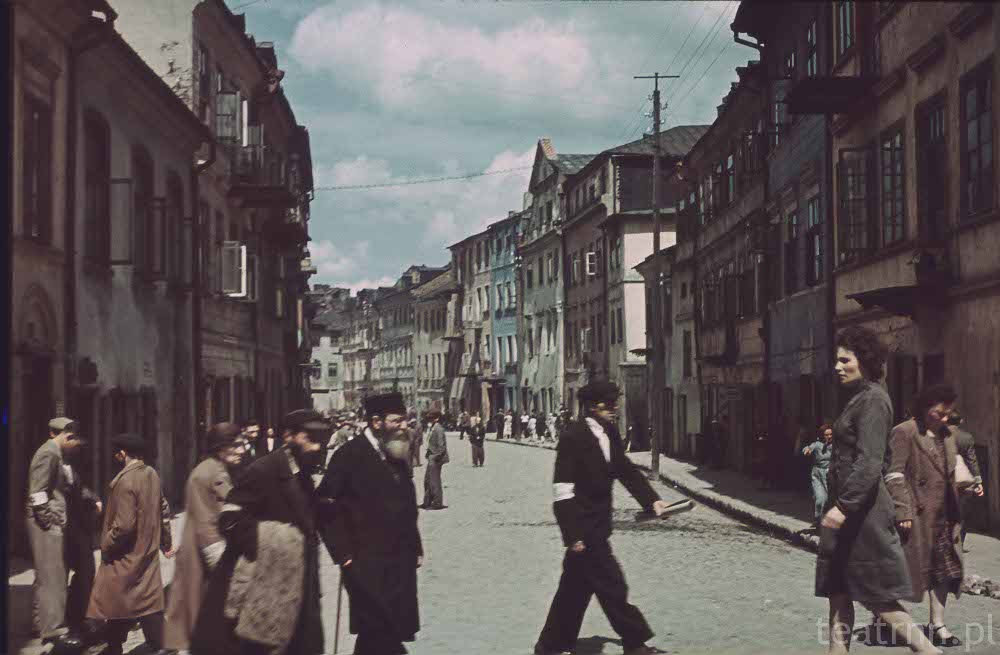 Dowiedz się o getcie w Lublinie Dowiedz się o getcie w Lublinie Lublin Castle overlooking the Jewish Quarter Lublin Castle overlooking the Jewish QuarterDuring the Second World War the Nazis annihilated not only the Jewish population of Lublin but also objects connected with it. By 1943 Jewish districts in Podzamcze, Kalinowszczyzna, Piaski and Wieniawa were destroyed. The concentration camp in Majdanek is a symbol of those times. Almost 360 thousand people including about 100 thousand Jews suffered martyr deaths there. After the war the State Museum of Majdanek was established on the premises of the former concentration camp (67 Droga Meczennikow Majdanka) The museum is open daily, except days following holidays, from 8 a.m. to 3 p.m.; May - October from 8 p.m. to 6 p.m.; telephone: +48 (81) 744-26-40 and 744-26-48.  The mausoleum of the martyrs of Majdanek The mausoleum of the martyrs of Majdanek
|
|
|
|
Post by pjotr on May 31, 2016 18:45:51 GMT 1
|
|
|
|
Post by jeanne on May 31, 2016 20:17:26 GMT 1
Dear Jeanne, I could have not filmed Dit is Arnhem without the input I received, the books I read, the documentaries I saw, the images on these two Polish Culture Forums before, and my travels to Poland (the synagogues of Krakow and Warsaw which I saw there), Prague, Budapest, the wonderful Alt-neu synagogue of Berlin, reading 'Jerusalem of the West of Siegfried van Praag', the soul of my jewish friends and their stories about shuls and shabats, my visits to the Portuguese synagogue in Amsterdam and the Jewish Historical Museum there. I tried to do my best to film from every angle and corner and the basic elements and atmosphere of the mosque. And imagined a full synagogue with the pre-war congregation. I would not have posted all this information and put so much effort in it if Bonobo wouldn't have started this incredible interesting thread about the heritage of the Polish jews and their houses of Worship in various Polish cities. By showing this, serching, finding and posting this information we show Polish and jewish history in Poland. Because Poland was and is built by it's Roman-Catholic majority, but also by it's Polish Jewish, Lutheran Protestant and Roman-Catholic German, Orthodox christian Ukrainian and other minorities and even some Dutch Mennonites and Calvinists (today Polish Calvinists). Cheers, Pieter Pieter, I'm glad that Bonobo got your started on this thread because you have shared a wealth of information! Thanks to both you and Bonobo for doing this. I am just so amazed by the photos/drawings of the synagogues. While I've read much of the history during WWII times, I don't think I have ever seen photos like these. I had no idea the synagogues were so magnificent and elegant, or that the Jewish culture was so vibrant and thriving pre-war! Thanks so much; I can tell even without your remarks, that this is a subject close to your heart. Jeanne |
|
|
|
Post by jeanne on Jun 1, 2016 0:42:04 GMT 1
Dear Jeanne, Jews in my opinion played the same role in Poland as in the Netherlands. They were compatriots with just another faith, but were Polish and Dutch Patriots like the christian Poles and Dutch. You could say the same about Germany before the Nazi's, the jews were German patriots there and very assimilated. They say German jews were very German, more than the Polish jews. Like in Poland the jews over here in Western-Europe were very diverse and even polarized. Jewish workers and jewish employers (bosses) with different interests. The architecture of the Synagogues often had oriental influences, but also the influence of Protestant, Bysantian (Greek Eastern-Orthodox Christian), Roman-Catholic, and Lutheran churches. Also some oriental Turkish (Ottoman), Moorish (North-African) and Palestinian-Israelite inlfuences are visible. You had rich Jewish merchants, bankers, Industrialists, businessmen, doctors, lawjers, and Jewish communities who invested in building a synagogue. Sometimes they had jewish architects, but often the architects weren't jewish at all and were architects who also had built churches, monastries, abbeys, palaces of kings of high nobility. In the Netherlands synagogue architecture had a significant inlfuence of the Reformation, the new church architecture of the Calvinist Dutch-Reformed Protestant churches. In the Netherlands the Ashkenazi Jewish community even calls itself the Dutch Israelite Church Community (NIK; Nederlands Israelitisch Kerkgenootschap). And the Sephardic Portugese Synagogue calls itself Portuguese Israelite community, like some Dutch Reformed communities (who use the word community in staid of Church). Next to these two main Jewish religious organisations you have the seperate Progressive Jewish community (Called Liberaal Joodse Gemeente in Dutch), the Conservative Masorti community and Reconstructionist Judaism. Pieter, I most definitely see the various influences on the architects of the synagogues, and was surprised how very similar they are to Catholic churches on the interior. The influences are there on the exterior, too. The onion domes surprised me especially. While in the church architecture of the western churches the towering spires represent mankind's striving upward to God, in the eastern churches the onion domes represent the downward movement of the Holy Spirit toward the earth...so it was interesting to see both of these configurations as part of Jewish synagogues...but then again, the roots of Christianity are in Judaism, with Jews as the "elder brothers" of Christians, as St. Pope John Paul II said! Jeanne |
|
|
|
Post by pjotr on Jun 1, 2016 1:42:03 GMT 1
Dear Jeanne,
I agree with you that the roots of Christianity are in Judaism. Jesus Christ and the first christians were jews. Most scholars agree that Jesus was a Galilean, Jewish rabbi who preached his message orally, was baptized by John the Baptist, and was crucified by the order of the Roman Prefect Pontius Pilate. I also agree with St. Pope John Paul II statement that the Jews are the "elder brothers" of us Christians.
We share many values, ethics, traditions and even ethnicity with them. Dutch, Polish, German and American jews are very close to us, because they have a lot of European Slavic, Germanic and Latin-Romanesque genes next to Semitic. In my view ethnically they are even closer to us than to the Arabs, Kurds, Persians and Turks. We christians inter married with them, conversed them, mixed with them, lived next to them, collaborated with them, studied them, enjoyed their work of art, literature, theology, philosophy, political theory, psychology, sociology, psycho-analysis (Sigmund Freud and Otto Rank).
They are very close to us or to me, a close and dear cousin of mine is Jewish. Jews are different from Christians in their strict monotheism, different in a total acceptable and ejoyable manner. I can't get my christianity and Roman-Catholicism out of me like my jewish friends can't seperate from their jewishness and thus Judaism. Judaism enriched Poland, the Netherlands, Germany, France, Russia, the Baltic states, Belarus, Ukraine, Hungary, the Czech Republic, Austria, Portugal, Spain, Italy, Northern-Africa, the Arab world, Persia, Turkey and Kurdistan, South-Africa, Suriname (Southern-America), Israel (Palestine, despite the tragic situation over there), Great-Britain, Australia and New Zealand, Scandinavia, due to their humanism, trade, innovation (science and culture), humor and cabaret (wit), sensitivity, elegance, style, and bravery. Staying in a hostile sometimes alien world of Germanistic, Slavic, Latin peoples who often didn't wanted them and who wanted them dead, evicted or to be isolated. They survived and developped themselves intellectually via Thora and Talmud studies, writing, philosophy, trade, banking, and finally by associating and allying themselves with the countries they live in and in the same time being proud of their state Israel.
Israel is very important to them, because they were discriminated, limited, curfewed, occupied, isolated and enslaved in other nations. They could not profess certain professions, certain roles, certain positions in those nations. Couldn't posses land, be farmers, police officers, judges, or other professions. For the jews it is important to have a state in which they are connected to a soil due to a biblical connection (the promised land), and in the same time via secular, life philosophy, rational and traditional reasons like for instance a socialist one. They could build a socialist agricultural commune (collective community there) on Jewish socialist foundations, the Kibbutz (a collective community in Israel that was traditionally based on agriculture) and the Moshav (a cooperative agricultural community of individual farms pioneered by the Labour Zionists during the second wave of aliyah -the immigration of Jews from the diaspora to the Land of Israel-), or they finaly could be Nationalists or Patriots like people of other new European nations in the 19th century (the new German and Italian state that emerged in the 19th century, and the French and British nationalism which already had older roots in the existing nations -think about the The Hundred Years' War from 1337 to 1453 between England and France-), and also European 17th, 18th, 19th and 20th century colonialism (The Portugese, Spanish, Dutch, British, French, Belgian and German colonialist empires) which was symbolised by the Ottoman and British colonial rule in Palestine and later Jewish colonialization by Jewish settlers in the occupied territories. I will not compare Israel with European colonialism, but fact is that Israel came out of an European colony, British Palestine.
To finish my story, it is very important for jews to own land and to work the land of Israel as farmers, builders, planters, constructors, making the land furtile and arable. It is important that there are Israeli jewish farmers, politicians, police officers, fire fighters, soldiers, doctors, teachers, nurses, artists, musicians, students, writers, poets, peace activists, workers, businessmen and that there are jews from all nations from all over the world who create that new melting pot. The merger of the Arab Mizrachi jews from Yemen, Iraq, Syria, Egypt, Morocco, Tunesia, Libiya, Egypt, Lebanon, Iran, Turkey, Kurdistan, and Sephardic jews from Spain, Portugal, Turkey and North-Africa too wit the Western Ashkenazim from the USA, Western-Europe, Russia, South-Africa, South-America creates the new people which are the new Israeli's. The Western Ashkenaz jews with their Germanic and Slavic dna, genes and features will become more Semitic again after mixing with Arab jews (Mizrachim) in Israel. In the same time the Black Ethiopian jews will integrate in the Israeli society. Next to that Asian, African and other immigrant make Israel a very multi-cultural society. Maybe Israel will look like Brasil in a few years, in Brasil all races also mixed. And they say that the most beautiful women come from Brasil (the perfect mix). Ofcourse taste differs. Some prefer Slaic looks, some prefer Germanic looks (tall blond, Nordic, blue eyed Dutch or Scandinavian girls, like in the Paris Follies Bergere in the Moulin Rouge/Montmartre area of Paris; or the Teutonic women of Helmut Newton -with his Germanic Nazi inspired tall blondes-), others prefer Southern Latin-Romanesque Italian/Portuguese/Spanish/Latin-American [Latino] look, or oriental Semitic (Arab/jewish), Armenian, Turkish, Kurd, Berber or Iranian, Indian Hindu looks, and yet other prefer beautiful black women. Tastes differ, and you have jewish ladies who are in every racial/ethnic version, like you have christian women in every ethnicity, and men and boys in every ethnic variety. Tastes differ, but jews are everywhere and in every ethnic version. That is their strength and their survival. But also Israel has to be careful that xenophobia, discrimination, racism, and humiliation of people due to their ethnicity won't take place. It is a fac that not all jews, arabs, muslims, christians and jews are equal there.
Cheers,
Pieter
|
|
|
|
Post by pjotr on Jun 1, 2016 17:07:03 GMT 1
Great Synagogue, Katowice Great Synagogue Great Synagogue was the largest synagogue in Katowice ( Kattowitz), Poland then Germany. It was built in 1900, designed by Ignatz Grünfeld. The synagogue was set on fire by Nazis on 4 September 1939. 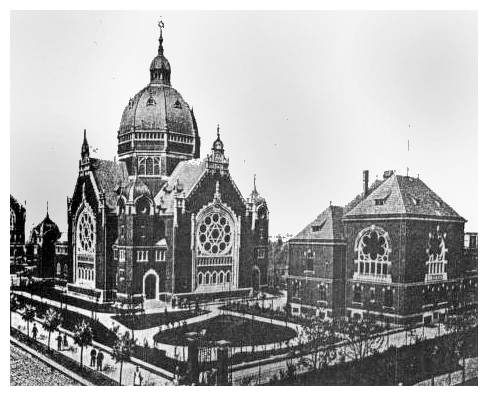 History HistoryThe plans to raise a new synagogue in Katowice arose around 1890, when the Old Synagogue ( Katowice) became too small for the local worshippers. The construction begun in 1896, and the architect in charge was Max Grünfeld, son of Ignatz Grünfeld who designed the old synagogue. The construction was finished in 1900 and the synagogue was opened on 12 October 1900.  The synagogue The synagogue was set on fire by Nazis on 5 September 1939, the day after they gained control of the city during the invasion of Poland ( 1939). After the war the few Jews who survived the Holocaust were unable to gather enough resources and support to rebuild the synagogue. Today in the place where this building once stood is a square ( Synagogue Square). In the 1988 a monument was raised in the square, dedicated to the Jewish inhabitants of the city who perished during the Second World War.  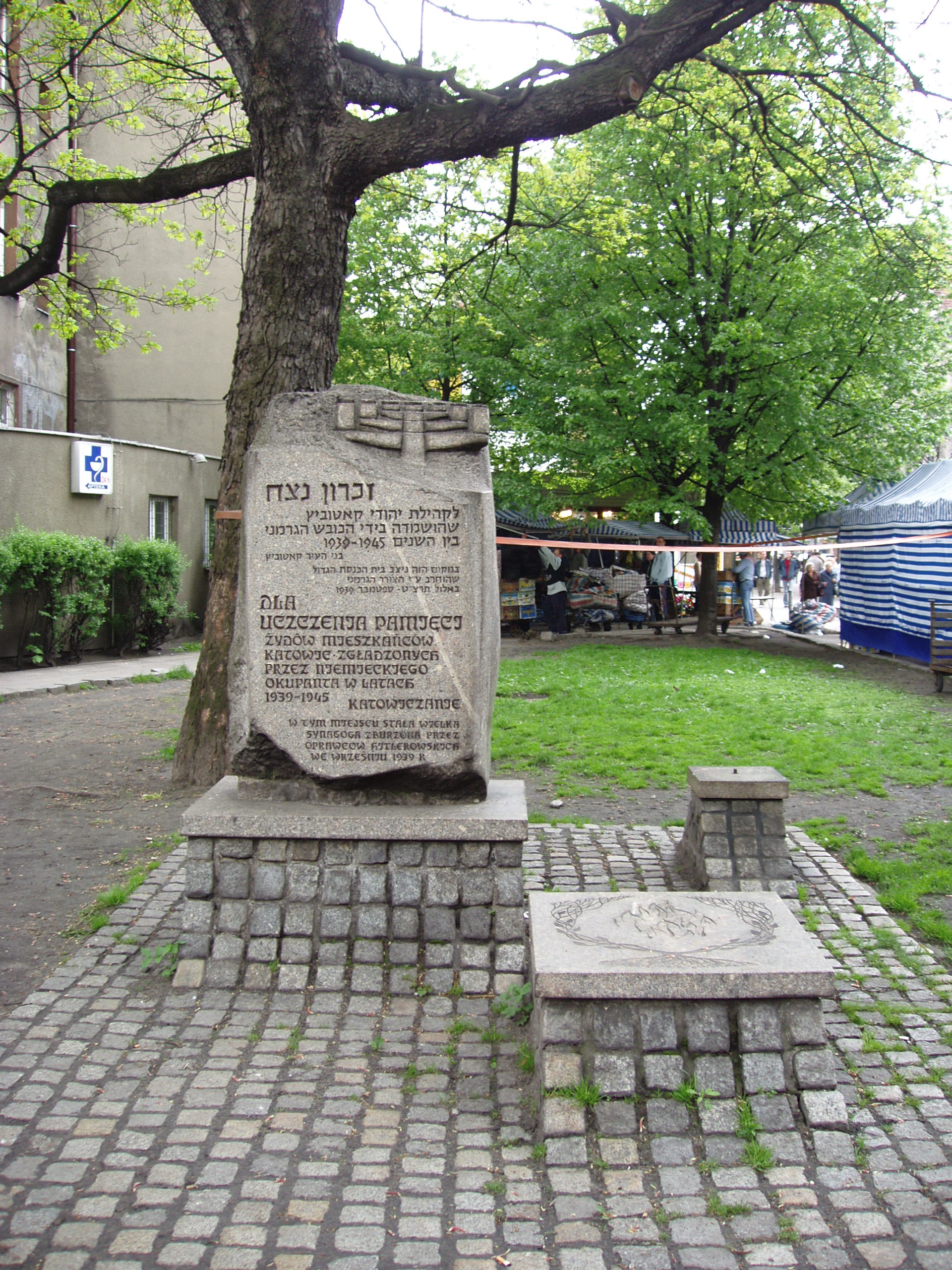 The monument at Synagogue Square; Katowice.Links:pl.wikipedia.org/wiki/Max_Gr%C3%BCnfeldpl.wikipedia.org/wiki/Ignatz_Gr%C3%BCnfeld The monument at Synagogue Square; Katowice.Links:pl.wikipedia.org/wiki/Max_Gr%C3%BCnfeldpl.wikipedia.org/wiki/Ignatz_Gr%C3%BCnfeld
|
|






































 (at least on the outside...)
(at least on the outside...)